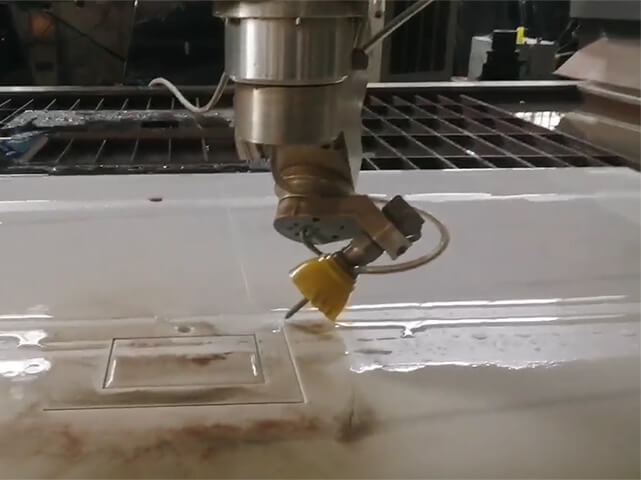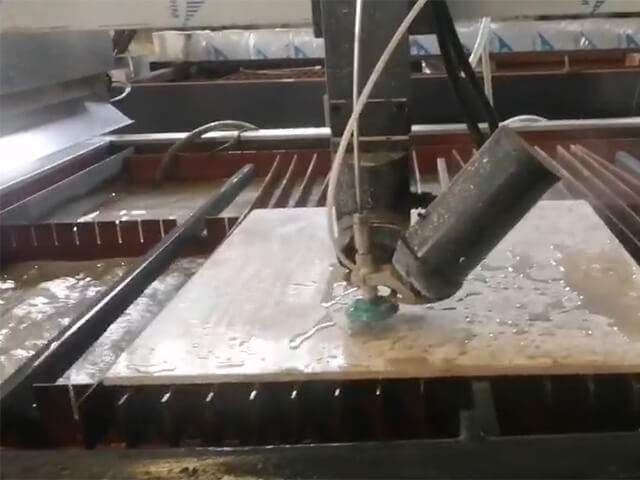Author:Dafon Kerbstone Machine FROM:Stone Machine Manufacturer TIME:2024-07-23
Waterjet cutting, also known as water jet cutting, is an advanced technology that uses high-pressure water to cut. Its working principle is to increase the water pressure to an extremely high level (usually more than 200 MPa), so that the water flow has huge kinetic energy, so that it can penetrate various materials, including metals, alloys, ceramics, stones, glass, plastics, rubber, textiles, etc.
A waterjet machine is a versatile cutting tool that uses a high-pressure stream of water, often mixed with an abrasive substance, to cut through a variety of materials. Here are some of its primary functions:
Precision Cutting: It can make highly accurate cuts in complex shapes and intricate designs, suitable for detailed work.
Cold Cutting: The process does not generate heat, preventing thermal distortion or damage to the materials being cut.
Versatile Material Cutting: It can cut through a wide range of materials, including metals (like titanium, stainless steel, and aluminum), composites, stone, marble, floor tiles, glass, automotive components, gaskets, foam, rubber, insulation, textiles, and food products.
Environmentally Friendly: The cutting process does not produce harmful gases or dust, and the water used can often be recycled.
Smooth Edges: The cuts made by a waterjet are smooth and precise, often eliminating the need for secondary finishing processes.
Efficiency: It is capable of quickly cutting large volumes of material, making it ideal for both small-scale and large-scale production.
These capabilities make waterjet machines valuable in industries such as manufacturing, aerospace, automotive, construction, and art.

Water jet cutting is an efficient, precise, heat-free processing method that can be used to cut a variety of materials. However, since the target distance of the water jet is uncertain and will decay with distance, its maximum cutting thickness is difficult to clearly define.
Factors affecting water jet cutting thickness:
Water jet flow and pressure: The stronger the flow and pressure, the stronger the cutting ability of the water jet, and the greater the thickness that can be cut.
Material properties: Different materials have different hardness, toughness and thermal conductivity, and their cutting resistance to water jets is also different. Generally speaking, the higher the hardness and toughness of the material, the smaller the thickness that can be cut.
Cutting accuracy requirements: If the cutting accuracy requirements are high, the cutting speed needs to be reduced, which will also result in a reduction in the thickness that can be cut.
Summary: According to data reports on the market, the normal cutting thickness value has a large range: between 100-500mm

CNC water jet is an efficient, precise, and heat-free processing method that can be used to cut various materials. Its cutting efficiency mainly depends on the following aspects:
1. Cutter head structure and quality:
The structure of the cutter head directly affects the formation and stability of the water jet. A good cutter head structure should ensure that the water jet is ejected at high speed and evenly, and minimize energy loss.
The quality of the cutter head also affects the cutting efficiency. High-quality cutters should be made of wear-resistant and corrosion-resistant materials and have good processing accuracy.
2. Water jet pressure:
Water jet pressure is a key factor affecting cutting ability. The higher the pressure, the stronger the cutting ability and the higher the cutting efficiency.
However, it should be noted that excessive pressure will cause excessive damage to the material and even lead to a decrease in cutting quality. Therefore, it is necessary to select a suitable water jet pressure according to the characteristics of the material.
3. Water nozzle:
The water nozzle is a key component in forming a water jet. The size, shape, and material of the nozzle will affect the characteristics of the water jet, and thus affect the cutting efficiency.
A worn or damaged nozzle will reduce the quality of the water jet and lead to a decrease in cutting efficiency. Therefore, the nozzle needs to be checked and replaced regularly.
4. Abrasive:
Abrasive is the main consumable of water jet cutting. The particle size, hardness and flow rate of the abrasive will affect the cutting speed and quality.
Selecting abrasives of appropriate specifications can improve cutting efficiency. For example, for harder materials, abrasives with larger particle sizes can be used; for thinner materials, abrasives with smaller particle sizes can be used.
5. Sandblasting tube:
The sandblasting tube is a pipe for conveying abrasives. The inner diameter, material and length of the sandblasting tube will affect the fluidity of the abrasive, and thus affect the cutting efficiency.
A blocked or damaged sandblasting tube will result in poor abrasive delivery and reduce cutting efficiency. Therefore, the sandblasting tube needs to be checked and cleaned regularly.

Environmental protection: Water jet uses ordinary water for cutting, and does not produce any additional substances. It is an environmentally friendly cutting method.
Easy workpiece fixing: Just place the workpiece on the cutting platform, no complicated fixing steps are required.
Cold cutting method: The water jet adopts cold cutting, which will not cause heat to the workpiece and avoid the problem of thermal deformation.
Easy image drawing: Only simple CAD drawing is required to complete the drawing of the cutting image, without cumbersome programming.
Strong equipment compatibility: The water jet can be used in conjunction with other processing equipment to make up for the shortcomings of other equipment.
Easy replacement of consumables: The replacement of consumables of water jet is very simple, even beginners can complete it in a few minutes. The main consumable is water jet sand.
Good cutting quality: The workpiece cut by water jet will not be deformed and has no burrs, reducing the need for secondary processing.
High cutting accuracy: The precision of water jet cutting is very high, exceeding many other cutting equipment.
Fast cutting speed: The cutting speed of water jet is among the best in the industry, and a large amount of cutting work can be completed in a short time.
Wide cutting range: Except for tempered glass, water jet can cut almost all materials.
The choice between a CNC laser cutter and a waterjet cutter depends on your specific needs and the materials you plan to work with. Here’s a comparison to help you decide which might be better for your application:
CNC Laser Cutter
Advantages:
Precision: Offers high precision and is ideal for intricate designs.
Speed: Generally faster for cutting thinner materials.
Material Efficiency: Minimal material waste due to narrow kerf width.
Clean Cuts: Produces clean edges with little to no finishing required.
Versatility: Suitable for cutting, engraving, and marking on various materials including metals, plastics, wood, and textiles.
Disadvantages:
Material Limitations: Limited effectiveness on thicker and reflective materials.
Heat Affected Zone (HAZ): Can cause thermal distortion or warping, especially in heat-sensitive materials.
Operating Costs: Higher operating costs due to the need for specialized gases and higher energy consumption.
Waterjet Cutter
Advantages:
Material Versatility: Can cut almost any material, including metals, stone, ceramics, composites, and glass.
No Heat Affected Zone: Cold cutting process eliminates thermal distortion or warping.
Thickness Capability: Can cut very thick materials, up to several inches.
Environmental and Operator Safety: No hazardous fumes or gases produced.
Disadvantages:
Abrasive Costs: Consumable abrasive materials can add to the operating costs.
Water Usage: High water consumption and the need for proper waste disposal.
Precision: While precise, it may not match the fine detail achievable with laser cutters.
Summary
Choose a CNC Laser Cutter if: You need high precision, speed for cutting thin materials, and clean, detailed cuts on metals, plastics, and other non-metallic materials.
Choose a Waterjet Cutter if: You need to cut a wide variety of materials, including very thick or heat-sensitive ones, and require a versatile, cold-cutting process without thermal distortion.
Ultimately, the better choice depends on your specific use case, material requirements, production volume, and budget.
Waterjet cutting machines typically operate at high pressures to cut through a variety of materials effectively. The pressure can vary depending on the specific machine and its intended application, but here are some general ranges:
1. Standard Waterjet Cutters: These machines usually operate at pressures between 30,000 to 60,000 pounds per square inch (PSI).
2. High-Pressure Waterjet Cutters: For more demanding applications, high-pressure waterjets can operate at pressures up to 90,000 PSI.
The high-pressure water stream is often mixed with an abrasive material (like garnet) to enhance cutting capability, especially for harder materials. The combination of high pressure and abrasive allows the waterjet cutter to slice through metals, stone, glass, ceramics, and composites with precision and minimal heat impact.